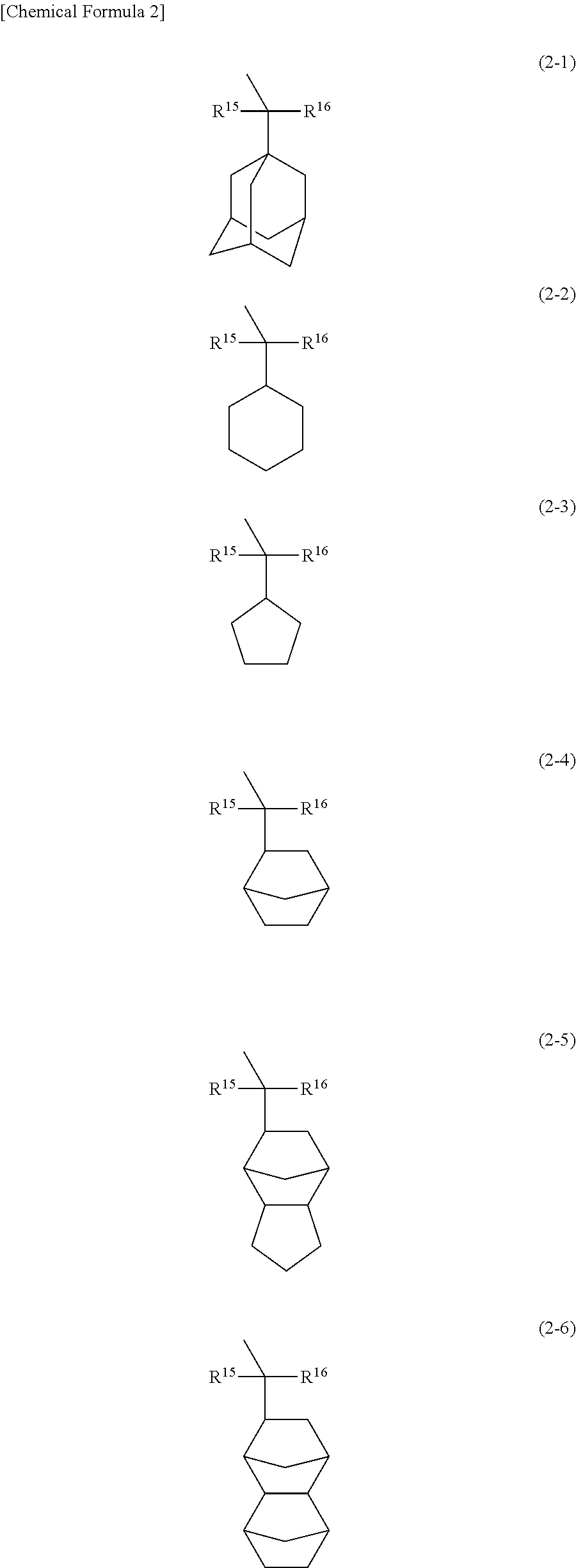Resist composition and method of forming resist pattern
a composition and resist technology, applied in the field of resist composition and resist pattern formation, can solve the problems of poor storage stability and lithography performance degradation upon storage, and achieve excellent storage stability and good lithography properties
- Summary
- Abstract
- Description
- Claims
- Application Information
AI Technical Summary
Benefits of technology
Problems solved by technology
Method used
Image
Examples
synthesis example 1
Synthesis of N-[2-(adamantan-1-ylcarbonyloxy)ethyl]trifluoromethanesulfonamide
[0894]A glass flask fitted with a thermometer and a condenser was charged with 100 g (0.52 mol) of trifluoromethanesulfonamide ethanol, 108.6 g (0.54 mol) of 1-adamantanecarboxylic acid, para-toluenesulfonic acid (0.1 mol) and 500 g of toluene, and a Dean-Stark dehydration apparatus was used to perform dehydration under reflux conditions. Refluxing for 9 hours enabled removal of approximately 9 ml of water. The resulting reaction mixture was dissolved in 500 g of ethyl acetate, and the thus obtained solution was washed twice with a saturated solution of sodium bicarbonate, once with 1N—HCl, and once with a saturated solution of sodium chloride. The organic phase was then dried over sodium sulfate, the solvent was removed by distillation under reduced pressure, and the product was recrystallized in hexane, yielding 140 g of N-[2-(adamantan-1-ylcarbonyloxy)ethyl]trifluoromethanesulfonamide (yield: 75%, purit...
synthesis example 2
Synthesis of triphenylsulfonium N-[2-(adamantan-1-ylcarbonyloxy)ethyl]trifluoromethanesulfonamide
[0899]A 3 L reactor was charged with 240 g (0.63 mol) of the N-[2-(adamantan-1-ylcarbonyloxy)ethyl]trifluoromethanesulfonamide obtained in the above Synthesis Example 1, 800 mL of water and 800 mL of chloroform, and with the temperature inside the reactor maintained at 0° C., 240 g (0.68 mol) of an 11% NaOH solution was gradually added dropwise to the reactor, and the resulting mixture was then stirred for 30 minutes. Subsequently, 244 g (0.71 mol) of triphenylsulfonium bromide was added to the reactor, and the reaction mixture was stirred at room temperature for 15 hours. A phase separation was then performed, and the obtained organic layer was washed 4 times with 800 mL of water and then concentrated under reduced pressure. The resulting yellow oily product was dissolved in acetonitrile and recrystallized in IPE, yielding 360 g of triphenylsulfonium N-[2-(adamantan-1-ylcarbonyloxy)ethy...
examples 1 to 4
Comparative Examples 1 to 3
[0904]The components shown in Table 1 were mixed together and dissolved to prepare a series of resist compositions.
TABLE 1ComponentComponentComponent Component Component Component (A)(B)(C)(G)(F)(S)Example 1(A)-1(B)-1(B)-2(C)-1(G)-1(F)-1(S)-1(S)-2[100][11.5][1.9][3.0][1.8][2.5][10.0][2900]Example 2(A)-1(B)-1(B)-2(C)-1(G)-2(F)-1(S)-1(S)-2[100][11.5][1.9][3.0][1.5][2.5][10.0][2900]Example 3(A)-1(B)-1(B)-2(C)-1(G)-3(F)-1(S)-1(S)-2[100][11.5][1.9][3.0][1.2][2.5][10.0][2900]Example 4(A)-1(B)-1(B)-2(C)-1(G)-4(F)-1(S)-1(S)-2[100][11.5][1.9][3.0][0.9][2.5][10.0][2900]Comparative(A)-1(B)-1 (B)-2(C)-1(G’)-1(F)-1(S)-1 (S)-2example 1[100][11.5][1.9][3.0][1.7][2.5][10.0][2900]Comparative(A)-1(B)-1 (B)-2(C)-1(G’)-2(F)-1(S)-1 (S)-2example 2[100][11.5][1.9][3.0][1.7][2.5][10.0][2900]Comparative(A)-1(B)-1 (B)-2(C)-1(G’)-3(F)-1(S)-1(S)-2example 3[100][11.5][1.9][3.0][2.6][2.5][10.0][2900]In Table 1, the numerical values in brackets [ ] indicate the amount added (in parts by...
PUM
| Property | Measurement | Unit |
|---|---|---|
| pKa | aaaaa | aaaaa |
| pKa | aaaaa | aaaaa |
| temperature | aaaaa | aaaaa |
Abstract
Description
Claims
Application Information
 Login to View More
Login to View More - R&D
- Intellectual Property
- Life Sciences
- Materials
- Tech Scout
- Unparalleled Data Quality
- Higher Quality Content
- 60% Fewer Hallucinations
Browse by: Latest US Patents, China's latest patents, Technical Efficacy Thesaurus, Application Domain, Technology Topic, Popular Technical Reports.
© 2025 PatSnap. All rights reserved.Legal|Privacy policy|Modern Slavery Act Transparency Statement|Sitemap|About US| Contact US: help@patsnap.com



